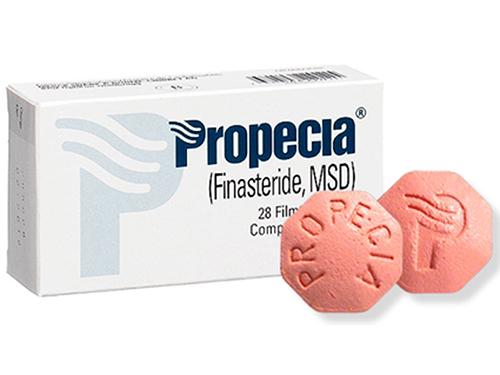
Hair loss treatment
Non-surgical methods
There are several non-surgical methods of treating male and female hair loss. Two medications, in particular, are available on the market today. Propecia is the name of the oral medicine that many doctors prescribe to treat hair loss in men. Propecia is the latest drug used for hair loss. Propecia is a 1 mg dose taken orally once a day and has shown over 80% effectiveness in growing hair. The active ingredient in Propecia is finasteride, which prevents the formation of DHT. The development of balding tissue is dependent on the circulating DHT.
What can Propecia do?
In two-year clinical studies in men between the ages of 18-41 with mild to moderate hair loss at the top of their heads, Propecia was shown to: Maintain or increase the amount of hair in 83% of men (vs. 28% taking placebo). Increase the amount of hair, decrease hair loss and improve appearance in most men reporting. Promote visible hair regrowth in 66% of men as determined by an independent panel of dermatologists.
How long does it take for Propecia to work?
Propecia works within about 3 months. Hair grows very slowly, about half an inch a month. Most men begin to see the first benefit of Propecia, slowing of hair loss, as easily as 3 months, and after 6 months begin to experience regrowth. Generally, you will not grow back all the hair you've lost.

Combination Therapy:
Propecia and Minoxidil can be used in combination for improved hair growth. Propecia and Minoxidil have different modes of action, they are synergistic in creating hair. Propecia inhibits DHT, while Minoxidil stimulates hair growth topically. Our studies have shown excellent results with this combination.
Possible Side Effects
Side effects from Propecia occurred in less than 2% of men tested in clinical studies performed by Merck and Co. These side effects were reversible and went away in men who stopped taking Propecia. They also disappeared in most men (58%) who continued taking Propecia.
The topical medication that treats hair loss is called Rogaine, also known as Minoxidil.
This medication was first administered internally to patients who were suffering severe high blood pressure. As a side effect of the drug, it was discovered that patients grew hair on various parts of the body. And, in some patients, when applied externally as a lotion, directly to the fine hairs remaining in a thinning area of hair on the scalp, the 2% solution of minoxidil was shown to start the hairs growing longer and thicker.Currently produced under the trade name of Rogaine Topical SolutionTM, the medication’s exact mechanism of action is unknown. We know it stimulates the hair follicles’ active growth (the Anagen phase), causing the hairs to thicken and grow longer. Minoxidil is helpful in slowing down the rate of hair loss in approximately 70%-75% of patients; and, about one in two patients actually experiences hair re-growth.Rogaine Topical SolutionTM is available over-the-counter (without a prescription) in both 2% and 5% concentrations. To be effective, the solution should be applied to your scalp twice daily. Our recommendation to patients is to shampoo and towel-dry your hair before applying the Rogaine solution. We also suggest using the dropper applicator to spread the solution over the entire top of the scalp and allow it to get onto the skin where it can do its job. We counsel patients to understand that it will take at least four months before you will notice less hair falling out; and, at least seven months to see hair re-growth. Usually, this re-growth will be fine, short (Vellus) hairs. Rogaine must be used continually, as prescribed, over the long-term in order to maintain its beneficial effects. If you stop using the medication, you will eventually begin to lose your hair again.The main side effects of Rogaine, which occur in approximately two percent of patients, are dermatologic: skin itching, scaling and redness. Minoxidil can be used by both MEN and WOMEN. Minoxidil is considered the “first-line“ of therapy for women with hereditary hair thinning.


